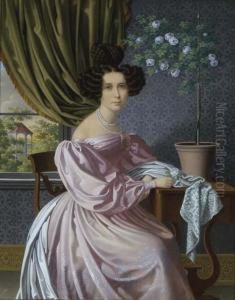Karl Friedrich Von Rahden Paintings
Karl Friedrich von Rahden was a German artist, known primarily for his work as a lithographer and painter. Born in 1815, von Rahden's artistic journey began in an era marked by significant changes in the European art landscape, with movements like Romanticism influencing the continent's cultural production. His contributions, however, leaned towards the detailed and meticulous art of lithography, a field that was gaining popularity for its ability to reproduce artworks and facilitate wider dissemination among the public.
Von Rahden's body of work encapsulates a range of subjects, from picturesque landscapes to detailed architectural studies, reflecting the artist's versatile interests and skills. His approach to lithography was characterized by a keen attention to detail and a commitment to realism, traits that made his works stand out during a time when this medium was often seen as secondary to painting. Through his prints, von Rahden captured the essence of his subjects with a clarity and precision that were highly valued by his contemporaries.
Beyond his contributions to lithography, von Rahden also engaged in painting, though this aspect of his oeuvre is less documented and celebrated. His paintings, like his prints, showcased his interest in realism and his ability to render subjects with accuracy and depth. Despite the overshadowing fame of his lithographic works, his paintings further attest to von Rahden's skills and his dedication to exploring different mediums.
Karl Friedrich von Rahden's career spanned several decades of the 19th century, a period that saw the rise of various artistic movements and the evolution of lithography as a respected art form. He died in 1874, leaving behind a legacy that, while perhaps not as widely recognized as that of some of his contemporaries, significantly contributed to the development of lithography and the visual documentation of his time. Von Rahden's works remain of interest to art historians and collectors, serving as valuable examples of 19th-century lithographic art and its potential for both artistic expression and historical documentation.
